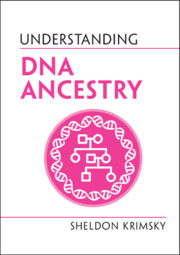Book contents
- Understanding DNA Ancestry
- Series page
- Understanding DNA Ancestry
- Copyright page
- Reviews
- Dedication
- Contents
- Foreword
- Acknowledgments
- 1 Introduction
- 2 The Business of DNA Ancestry
- 3 What Our Genomes Tell Us about the Geographical Origins and Movements of Early Human Populations
- 4 The Science behind DNA Ancestry Testing
- 5 Ancestry Informative Markers
- 6 Ancestry DNA Population Reference Panels
- 7 Comparing a Donor’s DNA to Reference Panel Populations
- 8 Probing Your DNA
- 9 Forensic Applications of Ancestry DNA Results
- 10 Privacy, Personal Identity, and Legal Issues
- 11 Discovering Unknown, Missing, or Mistaken Relatives
- 12 Accuracy, Consistency, and Validation of DNA Ancestry Tests
- 13 Conclusion
- Summary of Common Misunderstandings
- References
- Index
- Other books authored, coauthored, or coedited by Sheldon Krimsky
6 - Ancestry DNA Population Reference Panels
Published online by Cambridge University Press: 05 March 2022
- Understanding DNA Ancestry
- Series page
- Understanding DNA Ancestry
- Copyright page
- Reviews
- Dedication
- Contents
- Foreword
- Acknowledgments
- 1 Introduction
- 2 The Business of DNA Ancestry
- 3 What Our Genomes Tell Us about the Geographical Origins and Movements of Early Human Populations
- 4 The Science behind DNA Ancestry Testing
- 5 Ancestry Informative Markers
- 6 Ancestry DNA Population Reference Panels
- 7 Comparing a Donor’s DNA to Reference Panel Populations
- 8 Probing Your DNA
- 9 Forensic Applications of Ancestry DNA Results
- 10 Privacy, Personal Identity, and Legal Issues
- 11 Discovering Unknown, Missing, or Mistaken Relatives
- 12 Accuracy, Consistency, and Validation of DNA Ancestry Tests
- 13 Conclusion
- Summary of Common Misunderstandings
- References
- Index
- Other books authored, coauthored, or coedited by Sheldon Krimsky
Summary
In order to locate people’s ancestry to a region of the world through their DNA, the markers on their DNA sample have to be compared to population reference panels for the regions that form part of the comparison group. These ancestry inference methods have served medical research, forensic science, and commercial popular genealogical interests. According to Santo et al., the reliability of any ancestry inference depends on the existence of reliable population reference databases. Many researchers and ancestry DNA companies utilize different sources for population data on different countries. For example, ALFRED is an allele frequency database supported by the Yale Center for Medical Informatics, which has genomic data from population samples across the globe. You can enter the name of a country or population group, such as Siberian Yupik (the sample was collected from unrelated Siberian Yupiks from northeastern Siberia, Russia) and it will provide information on the number of people (29) and/or chromosomes sampled (58).
Keywords
- Type
- Chapter
- Information
- Understanding DNA Ancestry , pp. 50 - 59Publisher: Cambridge University PressPrint publication year: 2021

